Ann Cary Randolph Morris facts for kids
Quick facts for kids
Ann Cary Randolph Morris
|
|
|---|---|
| Born |
Ann Cary Randolph
1774 |
| Died | 1837 (aged 62–63) Morrisania, New York, U.S.
|
| Spouse(s) | |
| Children | Gouverneur Morris Jr. |
| Parent(s) | Thomas Mann Randolph Sr. Ann Cary Randolph |
| Relatives |
|
Ann Cary Randolph Morris (1774–1837), also known as Nancy, was an important woman in early American history. She was the daughter of Thomas Mann Randolph Sr. and later married Gouverneur Morris. As a young woman, she faced some difficult challenges. However, after marrying Gouverneur Morris in New York, she became a respected member of society again.
Ann was very dedicated to her son, Gouverneur Morris Jr. (1813–1888). She called him her "richest treasure." They lived at Morrisania, which is now part of the Bronx in New York City. Her son later built the St. Ann's Episcopal Church in her memory.
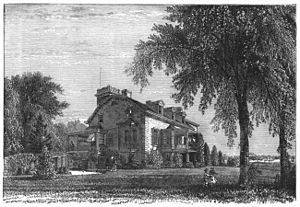
Ann's Early Life
Ann Cary Randolph was born in 1774 near Richmond, Virginia. Her childhood home was Tuckahoe Plantation. Her parents were Thomas Mann Randolph Sr. and Ann Cary Randolph. She grew up with 12 brothers and sisters. Her family, the Randolph family of Virginia, was very well-known. They were one of the First Families of Virginia.
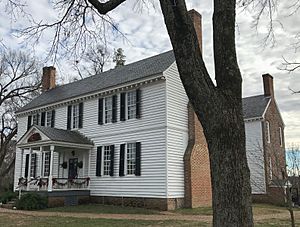
Tuckahoe Plantation was famous for its lively parties and beautiful gardens. It was known for its fine wood paneling and lovely boxwood plants.
[Tuckahoe plantation was] the scene of boisterous barbecues, fish fries, and fancy dress balls. The clapboard mansion was known throughout the colonies for its fine walnut paneling and fragrant boxwood gardens. Done up in velvet and gold, the colonel’s bedroom was the stuff of legend; the stables housed some of the fastest horses in the South.
—Alan Pell Crawford
Ann was close friends with her cousin, Martha Jefferson Randolph. In March 1789, Ann's mother passed away. The next year, her father married a woman named Gabriela. Gabriela was about Ann's age.
By the time Ann was 16, she had many people who wanted to marry her. She was described as a charming girl. Ann and her stepmother had disagreements. Because of this, Ann was asked to leave her home.
Marriage to Gouverneur Morris
In October 1808, Ann was living in New York. She received a visit from Gouverneur Morris. She had first met him years before at Tuckahoe Plantation. After they wrote letters to each other for a while, Ann accepted a job as his housekeeper.
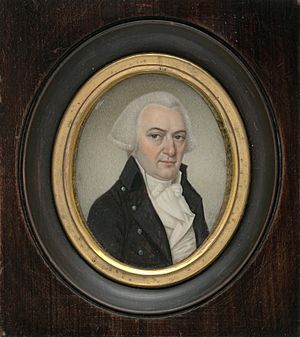
Gouverneur Morris was an important figure. He was a senator for New York. He also helped write the United States Constitution. He was an ambassador to France under President George Washington. In April 1809, Ann moved to his home, Morrisania.
On Christmas Day in 1809, Ann and Gouverneur surprised their guests by getting married. Ann wore her simple housekeeping dress as her wedding gown. This choice showed her thankfulness for his kindness. For Morris, it added an element of surprise for their guests.
Life as a Married Woman
Marrying a respected person like Gouverneur Morris helped Ann regain her social standing. From June to September 1810, the couple traveled. They inspected land for the future Erie Canal. In December 1811, they visited the White House. They met President James Madison and First Lady Dolley Madison. They also socialized with other political leaders.
In 1815, Ann recommended Samuel Larned for a diplomatic job. She wrote a letter to President Madison. Larned later had a long career in diplomatic service.
Ann and Gouverneur had one child, Gouverneur Morris Jr., in 1813. In October 1813, Gouverneur was away from his family. He wrote a poem for Ann in a letter. After he returned home, they spent only one other night apart. Ann later had the poem published in a magazine.
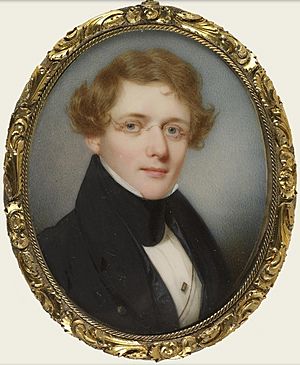
Ann kept in touch with her family and friends in Virginia. This included her sister Judith and Judith’s sons. One of her nephews, Tudor Randolph, became very ill. Ann took him into the Morrisania mansion and cared for him. Tudor later traveled to England hoping to get better, but he passed away in August 1815. Judith died in 1816.
Ann faced some challenges to her reputation. There were rumors about her in New York. Some of Gouverneur Morris's relatives were also upset. They were no longer going to inherit his estate because he married Ann and had a son.
Gouverneur Morris died on November 6, 1816, at Morrisania. Ann and her son continued to live there until she passed away in 1837. Ann focused on making sure her son received a good education. He later became a railroad executive. He also helped start the Republican Party. He married his cousin, Martha "Patsey" Jefferson Cary. She was the daughter of Ann's younger sister, Virginia Randolph Cary.
Ann worked hard to defend her character. She used the press, friends' advice, and lawyers. Her efforts, and her husband's before he died, helped restore her good name. She also managed her husband's estate. It had lost some value due to mismanagement by one of his nephews. Ann made sure her son would inherit a secure estate.
Ann died in 1837. Her son built the St. Ann's Episcopal Church in her memory. It was built on the grounds of Morrisania.
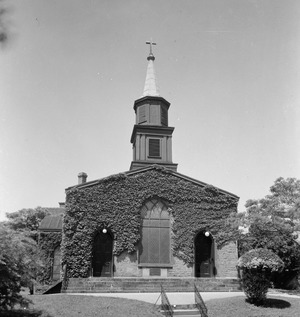
Gouverneur Morris born Feb. 9, 1813; died Aug. 20, 1888. Founder of this Parish, to which he gave church and lands for the glory of God and in memory of his mother.
—Inscription on a plaque at St Ann's Episcopal Church.
Ann and Gouverneur Morris are buried together in a family crypt at St. Ann's Church.
Images for kids
-
Morrisania mansion of Ann and Gouverneur Morris and their son. St. Ann's Episcopal Church was built on the grounds of the former mansion.
-
Tuckahoe Plantation, the birthplace and childhood home of Ann Cary Randolph Morris.
-
Pierre Henri, Gouverneur Morris, 1798, watercolor on ivory, Metropolitan Museum of Art, New York
-
Thomas Seir Cummings, Gouverneur Morris Jr. (1813-1888), 1840, Walters Art Museum.
-
St. Ann's Episcopal Church, 1934. It was made a New York City landmark in 1967






